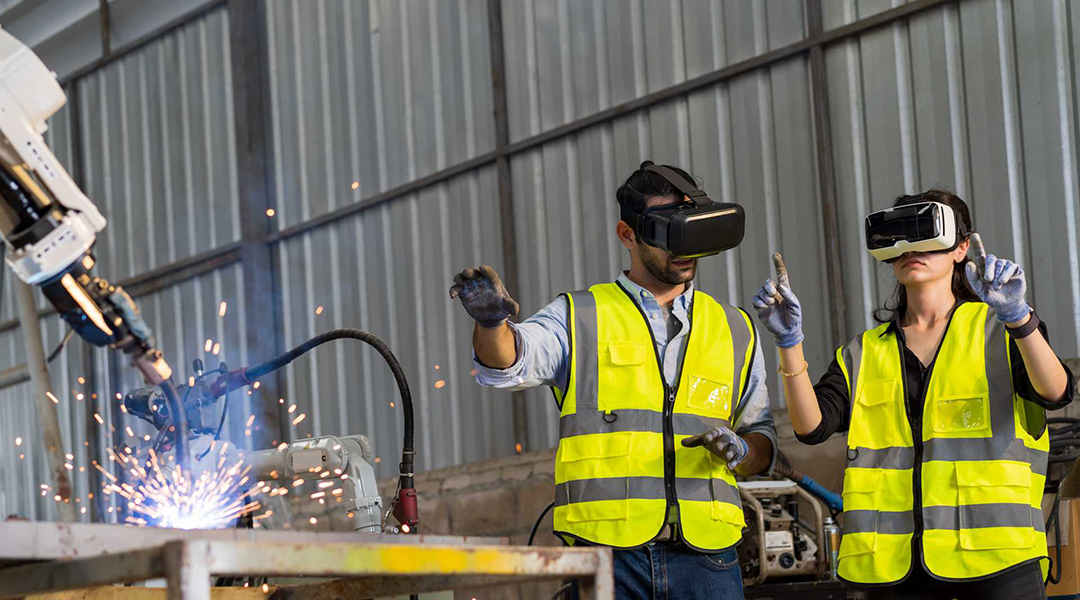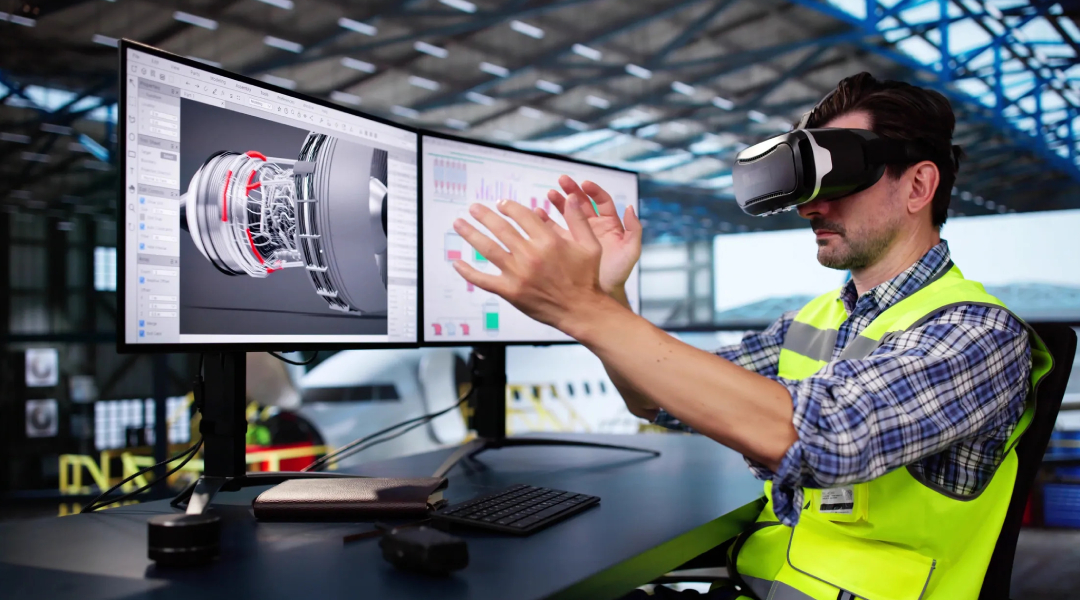Medicine is at the forefront of human advancement, continuously pushing the boundaries to enhance the accuracy and efficacy of healthcare solutions. Innovations in technology play a pivotal role in preserving and extending human life, marking significant milestones in the pursuit of medical excellence. Virtual reality technology, in particular, has emerged as a beacon of progress, significantly elevating the quality and precision of medical training and therapeutic interventions.
Recent research underscores the transformative impact of virtual reality applications on the medical field, mainly surgical training. A notable study highlighted that the integration of VR into the curriculum for laparoscopic surgery improved educational outcomes in 74% of the instances examined. Even more compelling, 87% of the studies reviewed revealed that practitioners who underwent training via virtual reality platforms demonstrated enhanced operational precision.
This article is all about demystifying the concept of virtual reality medical training simulations, exploring the myriad benefits these technologies bring to medical education, and providing guidance on selecting a VR app development company to meet specific needs in the healthcare sector. By simulating real-life surgical scenarios and medical emergencies, virtual reality training offers an unparalleled depth of immersive learning, enabling medical professionals to hone their skills without the immediate risks associated with live procedures.
Identifying virtual reality training companies that align with the specific objectives of medical VR training can significantly influence the effectiveness and reach of these programs. With the right partnership, institutions can leverage VR capabilities to advance medical education and training, ensuring that healthcare professionals have the knowledge and skills necessary to excel in their field. Integrating virtual reality into medical training represents a significant leap forward in the quest to enrich healthcare education and improve patient outcomes through innovative technological solutions.
What is VR Medical Training?
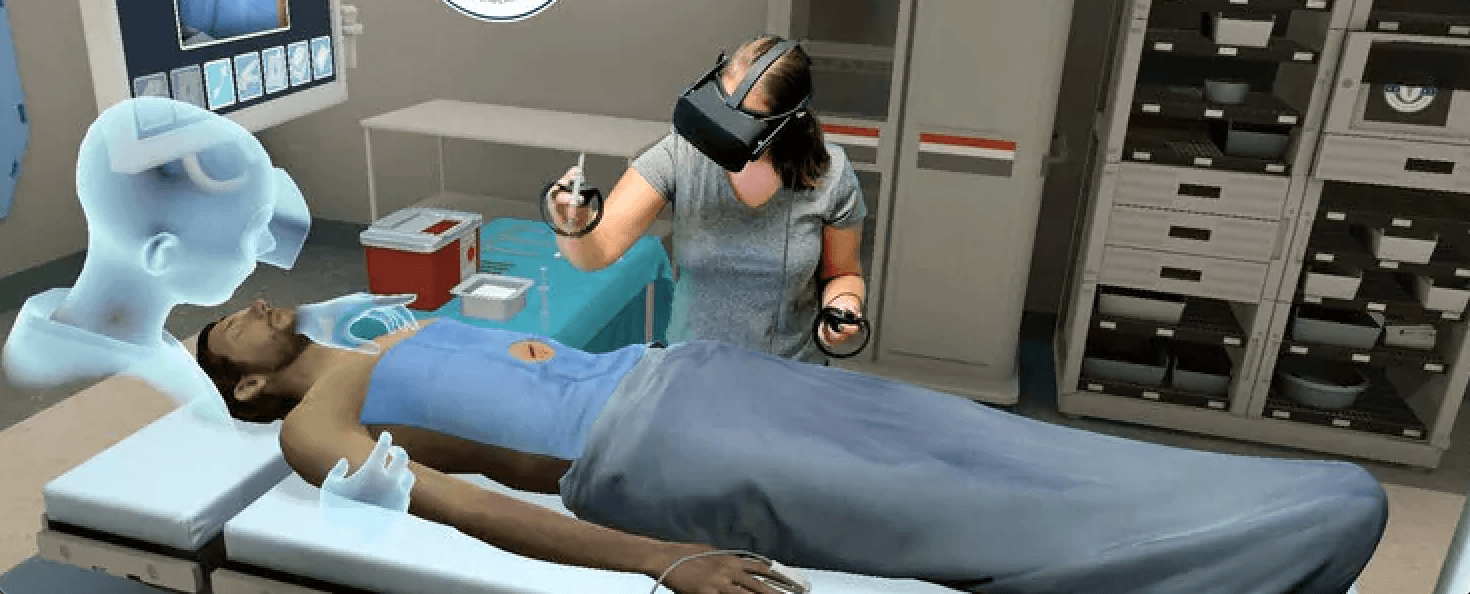
Virtual reality medical training represents a cutting-edge approach to enhancing the skill set of professionals within the healthcare sector. By employing this technology, individuals gain the opportunity to engage with a variety of scenarios within virtual environments. Such immersive experiences enable users to observe digital human anatomy from multiple perspectives and scales, facilitating a dynamic and interactive learning experience. Medical students and interns benefit from a more engaged form of education while practicing physicians have the chance to refine their skills with precision.
At the heart of virtual reality training lies the technology's capacity to create simulated environments that offer an immersive experience unparalleled by traditional methods. This simulation is delivered through a headset equipped with VR glasses and headphones, often accompanied by hand controllers to replicate movements, fostering a convincing sense of actuality. As a result, users can confront and manage situations that would otherwise be inaccessible due to real-world constraints, ranging from complex surgical procedures to emergency medical responses.
Virtual reality in medical education is transforming the landscape of learning and professional development in healthcare. By integrating VR medical training into the curriculum, educational institutions provide learners with the tools to experience highly realistic scenarios. This form of training empowers healthcare professionals to practice and perfect their techniques in a risk-free environment, enhancing patient care quality.
With its interactive and immersive nature, VR medical training is proving instrumental in preparing medical students and professionals for the intricacies of real-life patient treatment, offering a depth of training that bridges the gap between theoretical knowledge and practical application.
Adopting virtual reality training within the healthcare industry significantly advances medical education and professional development. This technology's ability to simulate detailed medical scenarios provides a unique platform for immersive learning. Through repeated practice in these virtual settings, healthcare professionals can improve their decision-making skills, technical abilities, and procedural accuracy, contributing to superior patient outcomes.
As virtual reality technology continues to evolve, its role in healthcare education and training is set to become even more pivotal, promising a future where medical professionals are better equipped than ever to address the challenges of modern medicine.
How is Virtual Reality Changing Medical Training?
Many educational institutions and hospitals have long been unable to provide a full-fledged practical course of study. It's more often not because of a lack of knowledge, but because they lack the resources to create all possible medical cases for students’ practice.
The limitations of the physical world don’t allow us to learn quickly and go through all possible scenarios of medical practice to know how to act in real life. That’s why VR training has come to the rescue. Take a look at some examples that show how virtual reality has improved medical training.
-
Students have got more real cases for study. Medical students often study with corpses in order to learn more about the human body and practice operations on the real body. Unfortunately, this does not give a full understanding of how the operation is performed on a living person. On the contrary, VR technology immerses students in real medical cases and suggests optimal actions while training.
-
Interactive training improved educational progress. VR technology immerses students directly in a simulated medical environment. Visual display of organs is shown in 3D, creating an atmosphere of a real operation, making it possible not only to study abstract theory and imagine situations in which you have never been but also get real experience from which you can learn more successfully.
-
The ability to explore the inside of a human body. Students can explore a human body from the inside without real intervention. The VR user can examine the body at an approximate scale and 360 °, as well as observe how organs work. The technology also makes it possible to trace how organs are connected throughout the body.
-
Hundreds of interactive medical cases. Patient treatment and operations don’t always go like scripts from textbooks. Situations and circumstances are different, so it takes many years to get an expert level of experience. VR medical training software generates hundreds of real cases and creates a real environment for them. Thus, students gain years of experience from a self-contained training course.
-
High-level further training. Medical education begins in college but never ends. Doctors undergo regular training in order to update their knowledge and prove that they are real professionals who can be trusted with human lives. VR training makes learning more comfortable and more effective at any stage of your career.
One more important advantage of VR training is that during education, the user can be accompanied by a virtual instructor who provides students with up-to-date information and guides them.
Unlock the future of care with our virtual healthcare training solutions!
Ways to Use Virtual Reality for Medical Training
As virtual reality technology continues to evolve, becoming more sophisticated and widely available, its applications within the healthcare sector are expanding in both diversity and depth. A closer examination reveals several key methodologies for employing virtual reality in medicine.
Virtual reality training has emerged as a transformative tool in the education of healthcare professionals. It offers a range of scenarios, from basic anatomy studies to complex surgical procedures. This method allows for an immersive learning experience, where medical students and professionals can engage with lifelike simulations, enhancing their understanding and proficiency in various medical tasks.
In VR medical training, practitioners find an invaluable resource for honing their skills. The immersive nature of virtual reality provides a unique opportunity to practice and repeat procedures in a controlled environment, drastically reducing the risk to actual patients. This approach not only improves the learning curve but also contributes significantly to the confidence and competence of healthcare providers.
Integrating virtual reality into medical education serves as a bridge between theoretical knowledge and practical application. By simulating real-life medical emergencies and treatment scenarios, VR medical training prepares students and professionals to face the challenges of their roles with greater assurance and capability.
Healthcare education is witnessing a paradigm shift with the adoption of virtual reality training techniques. These advancements in VR technology are enhancing the quality of medical training and setting new standards for precision and safety in healthcare services. Through virtual environments, learners can thoroughly explore the human body, practice surgical interventions, and develop critical decision-making skills in a risk-free setting.
The increasing application of virtual reality in medical training underscores a significant leap forward in healthcare education. As VR technology becomes more entrenched in the training of healthcare professionals, it promises to elevate the standards of patient care and medical proficiency for generations to come. Now let’s talk about some of the uses of VR in healthcare.
Virtual reality surgery training
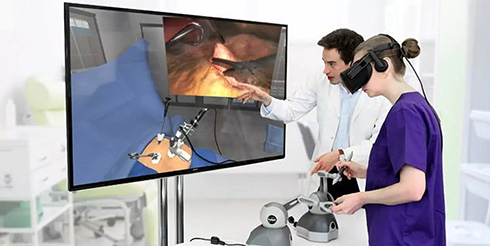
For students embarking on a journey in the medical field, the prospect of performing surgery on an actual individual carries inherent risks, even when conducted under the watchful eye of an experienced physician. The presence of an unseasoned practitioner can inadvertently extend the duration of a surgical procedure, a critical factor where every second is paramount.
In response to this challenge, 2019 saw the unveiling of a groundbreaking VR surgery simulation at the annual conference of the American Association of Orthopedic Surgeons (AAOS). This technology, equipped with a haptic glove, provides an immersive experience that closely replicates the tactile feedback and precise movements required during surgical operations.
By doing so, it paves the way for a significant advancement in medical VR training, particularly in the realms of anatomy education and surgical skill development. The adoption of virtual reality training in this context not only minimizes the likelihood of complications arising during surgeries but also marks a significant step forward in the utilization of VR in medical education.
This evolution toward incorporating VR medical training into the curriculum signifies a transformative shift in healthcare education, leveraging the potential of virtual environments to offer a risk-free, highly realistic platform for honing surgical techniques. The technology behind VR surgery simulations exemplifies the innovative approaches being taken to improve the quality of medical training. It underscores the commitment to enhancing patient safety and the efficiency of future healthcare professionals by providing them with a comprehensive, hands-on learning experience that transcends traditional methodologies.
By integrating virtual reality training into medical education, institutions are equipping aspiring surgeons with the necessary skills and confidence to perform under pressure without the immediate risk to patient health. VR medical training, through its detailed simulations of real-life medical scenarios, is redefining the parameters of professional preparedness in the healthcare sector. It illustrates the evolving nature of medical education, where virtual tools and real-world applications converge to foster a new generation of skilled, adept medical practitioners.
Rehabilitation with VR technology
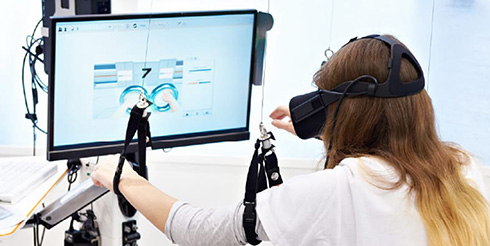
Virtual reality for therapy and training extends its benefits beyond the preparation of medical staff, playing a pivotal role in enhancing the transition from virtual-to-physical rehabilitation for patients. An illustrative example of this application is the hand rehabilitation app developed by Program-Ace, which facilitates a more efficient recovery process through engaging physical therapy sessions complemented by positive feedback following each achievement.
Patients engage with a virtual instructor throughout their rehabilitation journey, with real-time progress updates visible directly on their VR headset screen. This innovative product has been instrumental in aiding numerous patients to swiftly regain hand mobility and flexibility after experiencing trauma or battling illness.
Such applications of virtual reality in healthcare underscore the technology's versatility in both medical VR training and patient care. By integrating virtual reality training into the recovery process, healthcare providers can offer personalized and interactive rehabilitation experiences. This approach accelerates the healing process and contributes positively to the patient's motivation and engagement with their rehabilitation program.
The use of virtual reality for medical education and training exemplifies the transformative potential of VR technology in healthcare. Through VR medical training, professionals gain hands-on experience in a risk-free environment, while patients benefit from tailored rehabilitation programs that leverage virtual scenarios for physical recovery. This symbiotic relationship between VR medical training and patient rehabilitation represents a forward-thinking approach to healthcare education and service delivery, highlighting virtual reality's dual utility in fostering professional development and patient welfare.
Communication with patients
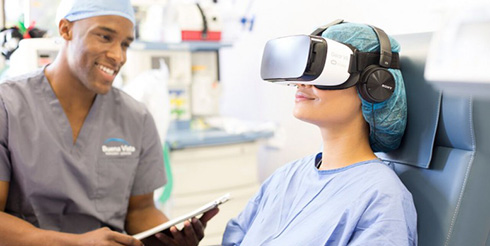
The apprehension associated with surgery, known as tomophobia, poses a significant challenge for patients facing surgical interventions. Healthcare professionals have identified that one primary source of this fear stems from the unknown; patients often harbor deep-seated anxiety about the process and outcomes of surgery due to a lack of comprehensive understanding.
Children, in particular, exhibit heightened levels of stress and anxiety when confronted with medical environments. To address this issue, specialists in a Los Angeles hospital have turned to virtual reality as a strategic tool to divert the attention of young patients during medical procedures. The implementation of virtual reality in this setting has been observed to markedly reduce anxiety levels, leading to smoother treatment processes and more efficient recovery periods, as reported by both parents and medical staff.
This innovative use of virtual reality in healthcare, particularly in VR medical training and patient care, showcases the technology's broad applicability. By incorporating virtual reality training into the healthcare sector, professionals are equipped with advanced tools for medical education and solutions that enhance patient experience and outcomes.
Virtual reality offers a dual benefit: enriching VR in medical education through realistic, immersive learning environments for professionals while simultaneously serving as a therapeutic tool that mitigates patient anxiety and improves the overall efficacy of medical interventions.
Incorporating virtual reality into medical settings, especially for alleviating tomophobia and enhancing patient care, underscores the significant impact of VR in healthcare. Healthcare professionals can gain a deeper understanding and hands-on experience in managing patient anxiety through the strategic use of VR in medical training.
Similarly, medical VR training techniques have proven instrumental in educating healthcare providers about innovative strategies for improving patient engagement and comfort. This holistic approach to integrating virtual reality in education and patient care initiatives represents a forward-thinking methodology in healthcare, leveraging the power of virtual experiences to foster a more informed, calm, and conducive environment for treatment and recovery.
Virtual reality emergency training
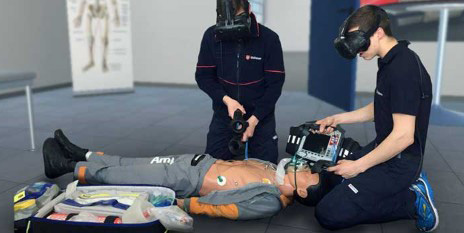
Emergencies present a critical threat to human life, necessitating swift and assured responses from healthcare professionals. The high emotional stakes involved in such situations exert considerable pressure on medical personnel, underscoring the need for extensive training to equip them with the skills to act promptly and precisely under stress.
To this end, the utilization of virtual reality for simulating emergency scenarios has become increasingly favored within medical education frameworks. A noteworthy instance of this approach is observed within Florida’s EMS Section, which employs VR headsets to train emergency responders specifically for pediatric emergencies. This innovative training method exposes learners to hundreds of varied scenarios that closely mimic the high-pressure conditions encountered in actual emergency settings. Consequently, this immersive experience significantly enhances the participants' ability to manage real-life emergencies effectively.
The adoption of virtual reality training in healthcare education, particularly for emergency response, represents a significant advancement in preparing medical professionals. Through VR medical training, trainees gain firsthand experience in navigating complex, high-stakes situations without the risk of real-world consequences. This method of medical VR training, especially within sectors like Florida's EMS Section, showcases the profound impact of virtual environments on learning outcomes. Trainees are not only educated on the technical aspects of emergency care but are also conditioned to maintain composure and decision-making clarity under pressure.
Integrating virtual reality into medical training programs offers a dynamic and realistic platform for healthcare education. The use of VR in medical training, especially in preparing individuals for emergency situations, harnesses the potential of virtual simulations to create authentic, high-intensity learning environments. This strategy not only improves the readiness of healthcare professionals to face emergencies but also plays a pivotal role in enhancing the overall quality of care provided to patients in critical situations. Through such immersive training experiences, the healthcare industry is evolving, with virtual reality leading the way in educational innovation, sparking excitement about the future of medical training.
Working with medical equipment
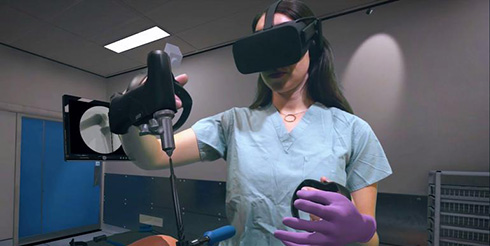
A precise and steady hand forms the cornerstone of a doctor's skill set, given the extensive range of equipment integral to medical practice that requires confident and adept handling. The interaction with a patient amplifies the stakes, as any inaccuracies can lead to complications, further emphasizing the critical nature of precision in medical procedures.
Virtual reality offers a solution to this challenge, providing an innovative platform for students, interns, and seasoned doctors alike to refine their skills in using medical devices. An example of this technology's application is a VR app designed to replicate the operation of a dialysis machine. This specific tool permits individuals to immerse themselves in the intricacies of kidney treatment procedures, affording them the liberty to practice extensively until they achieve mastery. Through such focused training, the app ensures that medical professionals can approach the actual use of a dialysis machine with confidence and precision, minimizing the risk of errors during patient care.
The integration of virtual reality training in the healthcare sector, particularly through applications like the VR app that simulates a dialysis machine, marks a significant enhancement in medical education and training protocols. By leveraging VR in medical education, institutions can offer a hands-on learning experience that closely mirrors real-world scenarios without the associated risks. This method of medical VR training, emphasizing the replication of critical medical equipment use, not only bolsters the technical proficiency of healthcare providers but also enriches their understanding of procedure-specific nuances.
Such VR medical training tools exemplify the fusion of technology with healthcare education, facilitating a more engaging and effective training process. The application of virtual reality in medical training serves not just to familiarize medical personnel with the operational aspects of complex machinery but also to instill a deeper sense of responsibility and accuracy when performing medical interventions. As healthcare continues to evolve, the adoption of virtual tools in education and training represents a forward-thinking approach to preparing the next generation of medical professionals, ensuring they are well-equipped to deliver high-quality patient care.
Choosing the Best Virtual Reality Medical Training Companies for Your App
The process of developing an application for VR medical training doesn’t take much time if specialists are with the right expertise working on the project. When choosing a reliable technical partner, experience, awards, and many successful projects speak for themselves.
Program-Ace is a software development service provider developing software for the medical industry with innovative technologies, such as the VR rehabilitation app we mentioned. Program-Ace is also an official member of the Forbes Technological Council and has received many awards and recognition, such as Top B2B companies, top VR/AR developers, and more.
We will be happy to develop custom software for training medical professionals and saving lives at the most optimal timelines for you. Contact us and we will discuss all your requirements and wishes.



